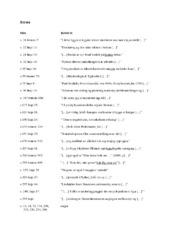| dc.description.abstract | This dissertation is entitled Knowledge and curiosity: Remarkable readings of three Norwegian text-montages for children and adolescent, and is divided into five equal parts and one appendix. The link between knowledge and curiosity can be traced in the span between the known and the unknown, the usual or ordinary and the unusual and extraordinary. What is unknown, unusual and extraordinary is called a curiosity. A curiosity is something remarkable, something strange, odd, and peculiar that has awaken our inquisitiveness. In Latin the noun cura means care, concern, carefulness. From cura the adjective curiosus is derived meaning careful, observant and concerned (as in cura-tor). The noun curiosum is probably a newer, scholarly variant of the word and means ‘something that makes us curious’. While knowledge is something known, something already there, a curiosity is something we find by employing a curious and observant gaze, and something we want to take care of, to care about and to collect. Part A introduces the three text-montages that are the focus of the dissertation: Einar Økland’s epistles Ingenting meir (1976, trans. Nothing more), Svein Nyhus’ picture book Verden har ingen hjørner (1999/2002, trans. The world has no corners) and Ragnar Hovland’s encyclopaedia-like Verdt å vite [trur eg] (2002, trans. Worth knowing [I think]). It also introduces the works of Walter Benjamin, which provide the thematic, methodical and theoretical guidelines of the dissertation. Secondly, Part A presents the notion of montage, provides examples and argues for its use as a method both for reading the three text-montages and for structuring the dissertation itself. Finally, an outline is provides of the main perspectives from which the three text-montages are viewed: those of the collector, of the collections and collecting; those of topography and topology; those of the biography; and those of knowledge and curiosity. Part B focuses on the montages of Økland, Nyhus and Hovland as text collections and on the authors as collector. There are three guiding questions: how do the collectors collect, how are the collections ordered, and what is collected? These questions are related to relevant texts by Benjamin, such as “The Collector”, “ The Cultural History of Toys” (my trans.), “Russian Toys” (my trans.), “Toy wandering in Berlin” I and II (my trans.) and Berlin Childhood Around 1900. The questions of how to order a collection and how to order a text are closely related to the ways in which one orientates oneself to different guidelines and follows these. Part C, therefore, studies various texts by Benjamin, Økland, Nyhus and Hovland that demonstrate the link between geography and geometry, and the link between topography and topology: i.e. the relationship between being able to read a map or a landscape and being able to read a literary text. If one can claim that topographic texts are spatial texts, one can also claim that biographies are linear texts. It is the meeting point between biography and topography in which I am interested, on the grounds that to write about someone’s life also means to map that person’s life. Part D of the dissertation challenges traditional patterns of biographical writing using examples from texts by Benjamin, Økland, Nyhus and Hovland. The analysis in Parts C and D conclude with the suggestion that one should view these three text-montages as an opportunity to learn how to lose one’s way and the value of going astray. Getting lost or going astray situates the readers outside the system, thereby enabling them to understand or orient themselves from a new or different point of view. According to Benjamin: ”Not to find one’s way around a city does not mean much. But to lose one’s way in a city, as one loses one’s way in a forest, requires some schooling” (Benjamin 2006, 53). The examinations of the various topographical and biographical texts are linked to different questions about knowledge: “Where is knowledge?”, “How is knowledge collected and ordered?” and “What is the value of knowledge?”. These questions are the focal point in Part E. The first question is answered on the basis of a text by Økland which maintains that knowledge can also be sought in remote corners and on the periphery. In answer to the second question, Nyhus’ illustrations and texts demonstrate that knowledge can be gathered and systemized in reliquaries, drawers and boxes. This understanding of knowledge may be read as a parallel to the epistemological value of the ‘Wunderkammer’ or ‘Raritäten- Kabinett’. The final question, regarding the value of knowledge, is adressed in relation to Hovland’s Verdt å vite [trur eg] and the science of pataphysics. One definition of pataphysics is that it is the science of exceptions. For Hovland, as well as for Økland and Nyhus, it is the exceptions, the particular and the curious details that are of epistemological value. In the appendix of my dissertation, five future fields of investigation arising from my analysis are indicated: “The activity of collecting in modern, Norwegian picture books”, “Topographical children’s literature”, “Biographies for children and adolescent”, “Animal’s significance in children’s literature” and “Children’s encyclopaedia”. This study demonstrates that the concept of the montage is a useful analytic tool. The dissertation Knowledge and curiosity: Remarkable readings of three Norwegian textmontages for children and adolescent offers experimental readings of three important Norwegian authors, and traces the connection between the way a text is organized and the way knowledge is understood. | en_US |

